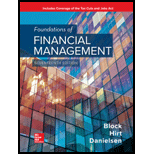
Concept explainers
a.
To calculate: The standard deviations of Year 1, Year 5, and Year 10.
Introduction:
Standard deviation (SD):
A statistical tool that helps measure the deviation or volatility of an investment is termed as the standard deviation. It is the square root of variance.
b.
To draw: The diagram of the mean (expected value) and SD for three years.
Introduction:
Expected value:
It is also known as mean. It is the value that is estimated or anticipated to earn in the future from an investment. It is computed by adding up the values that occur by multiplying each of the outcomes with their probabilities.
Standard deviation (SD):
A statistical tool that helps measure the deviation or volatility of an investment is termed as the standard deviation. It is the square root of variance.
c.
To calculate: The values and differences in the values of discount rates of 6% and 12% at Year 1, Year 5, and Year 10.
Introduction:
Discount Rate:
A rate that is used for the calculation of the present value of the cash flows is termed as the discount rate.
d.
To explain: The relation between the increase in risk overtime shown in the diagram in part (c) and the large differences in PVIFS computed in the part (b).
Introduction:
Risk:
The future uncertainty of the deviation between actual and expected outcome is termed as risk. Risk is the quantified representation of uncertainty that an investor is willing to take on the investments.
e.
To calculate: The investment is accepted on the basis of the NPV or not.
Introduction:
It is the difference between the PV (present value) of
Want to see the full answer?
Check out a sample textbook solution
Chapter 13 Solutions
EBK FOUNDATIONS OF FINANCIAL MANAGEMENT
- Replacement Analysis The Everly Equipment Company's flange-lipping machine was purchased 5 years ago for $75,000. It had an expected life of 10 years when it was bought and its remaining depreciation is $7,500 per year for each year of its remaining life. As older flange-lippers are robust and useful machines, this one can be sold for $20,000 at the end of its useful life. A new high-efficiency digital-controlled flange-lipper can be purchased for $130,000, including installation costs. During its 5-year life, it will reduce cash operating expenses by $45,000 per year, although it will not affect sales. At the end of its useful life, the high-efficiency machine is estimated to be worthless. MACRS depreciation will be used, and the machine will be depreciated over its 3-year class life rather than its 5-year economic life, so the applicable depreciation rates are 33.33%, 44.45%, 14.81%, and 7.41%. The old machine can be sold today for $50,000. The firm's tax rate is 25%, and the…arrow_forwardThe Gilbert Instrument Corporation is considering replacing the wood steamer it currently uses to shape guitar sides. The steamer has 6 years of remaining life. If kept, the steamer will have depreciation expenses of $700 for 5 years and $350 for the sixth year. Its current book value is $3,850, and it can be sold on an Internet auction site for $4,440 at this time. If the old steamer is not replaced, it can be sold for $800 at the end of its useful life. Gilbert is considering purchasing the Side Steamer 3000, a higher-end steamer, which costs $12,300, and has an estimated useful life of 6 years with an estimated salvage value of $1,200. This steamer falls into the MACRS 5-years class, so the applicable depreciation rates are 20.00%, 32.00%, 19.20%, 11.52%, 11.52%, and 5.76%. The new steamer is faster and allows for an output expansion, so sales would rise by $2,000 per year; the new machine's much greater efficiency would reduce operating expenses by $1,800 per year. To support the…arrow_forwardSt. Johns River Shipyards' welding machine is 15 years old, fully depreciated, and has no salvage value. However, even though it is old, it is still functional as originally designed and can be used for quite a while longer. A new welder will cost $181,500 and have an estimated life of 8 years with no salvage value. The new welder will be much more efficient, however, and this enhanced efficiency will increase earnings before depreciation from $28,000 to $78,500 per year. The new machine will be depreciated over its 5-year MACRS recovery period, so the applicable depreciation rates are 20.00%, 32.00%, 19.20%, 11.52%, 11.52%, and 5.76%. The applicable corporate tax rate is 25%, and the project cost of capital is 13%. What is the NPV if the firm replaces the old welder with the new one? Do not round intermediate calculations. Round your answer to the nearest dollar. Negative value, if any, should be indicated by a minus sign.arrow_forward
- Ends Apr 27 Explain why we start with Sales forecasts when we do our financial forecasting. What are the limitations of the Percent of Sales Forecasting method?arrow_forwardDescribe in detail what exactly is the Cash Conversion Cycle, how is it computed and what is the purpose of this calculation (how is it used).arrow_forwardExplain what Interest Rate Parity is, how it is calculated, and why it is important to a company operating internationally.arrow_forward
- Compare and contrast the three core means of adding shareholder wealth; Cash Dividends, Stock Dividends and Stock Splits, and Stock Repurchases. Include the various advantages and disadvantages of each one.arrow_forwardHow to calculate the future value?arrow_forwardhow to caculate the future value?arrow_forward
